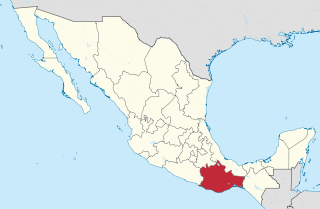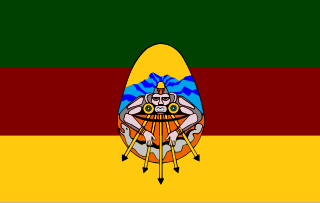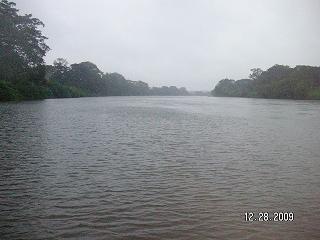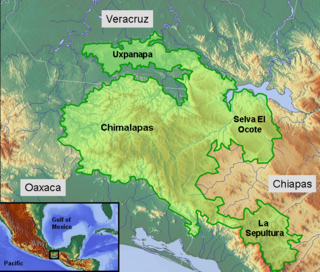
Chiapas, officially the Free and Sovereign State of Chiapas, is one of the states that make up the 32 federal entities of Mexico. It comprises 124 municipalities as of September 2017 and its capital and largest city is Tuxtla Gutiérrez. Other important population centers in Chiapas include Ocosingo, Tapachula, San Cristóbal de las Casas, Comitán, and Arriaga. Chiapas is the southernmost state in Mexico, and it borders the states of Oaxaca to the west, Veracruz to the northwest, and Tabasco to the north, and the Petén, Quiché, Huehuetenango, and San Marcos departments of Guatemala to the east and southeast. Chiapas has a significant coastline on the Pacific Ocean to the southwest.
The Huastec or Téenek are an indigenous people of Mexico, living in the La Huasteca region including the states of Hidalgo, Veracruz, San Luis Potosí and Tamaulipas concentrated along the route of the Pánuco River and along the coast of the Gulf of Mexico.

Oaxaca, officially the Free and Sovereign State of Oaxaca, is one of the 32 states that compose the Federative Entities of the United Mexican States. It is divided into 570 municipalities, of which 418 are governed by the system of usos y costumbres with recognized local forms of self-governance. Its capital city is Oaxaca de Juárez.

The Isthmus of Tehuantepec is an isthmus in Mexico. It represents the shortest distance between the Gulf of Mexico and the Pacific Ocean. Before the opening of the Panama Canal, it was a major overland transport route known simply as the Tehuantepec Route. The name is taken from the town of Santo Domingo Tehuantepec in the state of Oaxaca; this was derived from the Nahuatl term Tēcuāntepēc.

Tehuantepec is a city and municipality in the southeast of the Mexican state of Oaxaca. It is part of the Tehuantepec District in the west of the Istmo Region. The area was important in pre-Hispanic period as part of a trade route that connected Central America with what is now the center of Mexico. Later it became a secondary capital of the Zapotec dominion, before it was conquered by the Spanish in the early 16th century.

Mesoamerican languages are the languages indigenous to the Mesoamerican cultural area, which covers southern Mexico, all of Guatemala and Belize and parts of Honduras and El Salvador and Nicaragua. The area is characterized by extensive linguistic diversity containing several hundred different languages and seven major language families. Mesoamerica is also an area of high linguistic diffusion in that long-term interaction among speakers of different languages through several millennia has resulted in the convergence of certain linguistic traits across disparate language families. The Mesoamerican sprachbund is commonly referred to as the Mesoamerican Linguistic Area.

The Mixe are an Indigenous people of Mexico who live in the eastern highlands of the state of Oaxaca. They speak the Mixe languages, which are classified in the Mixe–Zoque family, and are more culturally conservative than other Indigenous groups of the region, maintaining their language to this day. SIL international estimated that 90,000 Mixe spoke Mixe language in 1993.

Huipil[ˈwipil] is the most common traditional garment worn by indigenous women from central Mexico to Central America.

El Corte River is the primary tributary of the Coatzacoalcos River, flowing through the Mexican states of Oaxaca and Veracruz to the Gulf of Mexico.

The Selva Zoque, which includes the Chimalapas rain forest, is an area of great ecological importance in Mexico. Most of the forest lies in the state of Oaxaca but parts are in Chiapas and Veracruz. It is the largest tract of tropical rainforest in Mexico, and contains the majority of terrestrial biodiversity in the country. The forest includes the Selva El Ocote, a federally-protected biosphere reserve, but is otherwise not yet protected. Despite the rich ecology of the region, a 2003 study that focused on bird populations stated that "the fauna of the heart of the Chimalapas, including its vast rainforests, have seen little or no study". As it is an impoverished region, efforts to preserve the ecology are often at odds with demands to improve the economy.

Istmo de Tehuantepec is the largest region of the state of Oaxaca, located in southwestern Mexico.

Juchitán District is located in the east of the Istmo de Tehuantepec region of the State of Oaxaca, Mexico, covering the southern part of a low-lying corridor through the mountains that separates the Gulf of Mexico from the Pacific ocean. The district has an area of 13,300 km2 and a population as of 2005 of 339,445.

The Indigenous people of Oaxaca are descendants of the inhabitants of what is now the state of Oaxaca, Mexico who were present before the Spanish invasion. Several cultures flourished in the ancient region of Oaxaca from as far back as 2000 BC, of whom the Zapotecs and Mixtecs were perhaps the most advanced, with complex social organization and sophisticated arts.

The state of Oaxaca, Mexico has a total population of about 3.5 million, with women outnumbering men by 150,000 and about 60% of the population under the age of 30. It is ranked tenth in population in the country. Fifty three percent of the population lives in rural areas. Most of the state’s population growth took place between 1980 and 1990. Life expectancy is 71.7 for men and 77.4 for women, just under the national average. Births far outpace deaths. In 2007, there were 122,579 births and 19,439 deaths. Approximately 85% profess the Catholic faith.
In the Central Valley region of the Southern Mexican state of Oaxaca archeologists discovered evidence of historic settlements. Aztecs from Tenochtitlan on the volcanic plateau to the North around what today is Mexico City first arrived in this region around 1250 AD establishing military rule in the 15th century until the arrival of the Spanish. After the fall of Tenochtitlan, the Spanish took over Oaxaca which led to the eventual decrease of the Native population and the increase in African slaves. The region was then settled by mostly Spanish immigrants from Europe and the African slaves they brought with them. Oaxaca was considered a department after the Mexican War of Independence, but after the fall of emperor Agustín de Iturbide, it became a state in 1824 with José Murguia as its first governor. During the 19th century, Oaxaca was split between liberal and conservative factions. The political and military struggles between the factions resulted in wars and intrigues. A series of major disasters occurred in the state from the 1920s to the 1940s. In the 1940s and 1950s, new infrastructure projects were begun. From the 1980s to the present, there has been much development of the tourism industry in the state.

Las Choapas is a recently found archaeological site located within the municipality of Las Choapas, in the southeastern border of the Veracruz State, inside the San Miguel de Allende Ejido, bordering the municipalities of Huimanguillo, Tabasco and Ostuacán, in Chiapas.

For more than 500 years, the indigenous Zoque people of Chimalapas in Southern Mexico have been victim of invasions in their territory. Chimalapas is a region with a large biodiversity and due to that it is of interest to, among others, the federal government, state governments, and a variety of companies. Therefore, throughout history several claims have been laid on this area. This goes against the will of the Zoque people, who want to take care of this land as they have done ever since they started living in this area.
The Spanish conquest of Chiapas was the campaign undertaken by the Spanish conquistadores against the Late Postclassic Mesoamerican polities in the territory that is now incorporated into the modern Mexican state of Chiapas. The region is physically diverse, featuring a number of highland areas, including the Sierra Madre de Chiapas and the Montañas Centrales, a southern littoral plain known as Soconusco and a central depression formed by the drainage of the Grijalva River.
Belisario Domínguez was one of the municipalities of the Mexican state of Chiapas, in southern Mexico. It was separated from the municipality of Cintalapa in 2011, although in reality it was a territory that was invaded by logging companies in the 1940s from the Zoque communities of the municipalities of Santa María Chimalapa and San Miguel Chimalapa (Oaxaca). In 2021, the Supreme Court of Justice of the Nation determined the suspension of the municipal powers instituted according to the laws of Chiapas in 2015 was lawful, despite the 2013 resolution of that same superior court, which prohibited both Oaxaca and Chiapas from establishing of municipal authorities in the territory. With this and the impossibility of holding elections in 2018, the municipality of Belisario Domínguez was abolished.
Luis Marin was a spanish conquistador who served first under Captain Francisco de Saucedo then later directly under Captain General Hernán Cortés himself during several military campaigns in New Spain including the fall of Tenochtitlan, the Hibueras campaign and many other deployments along southeastern Mexico, Guatemala and Honduras. He is known as the captain who lead many Conquistadors including famous Conquistador and memoir-writer Bernal Díaz del Castillo into several military campaigns to conquer or reconquer sections in southeastern Mexico. Marin would become a close friend and confidant of Cortés serving him from 1519 until 1531, the year after Cortes returned from Spain.












